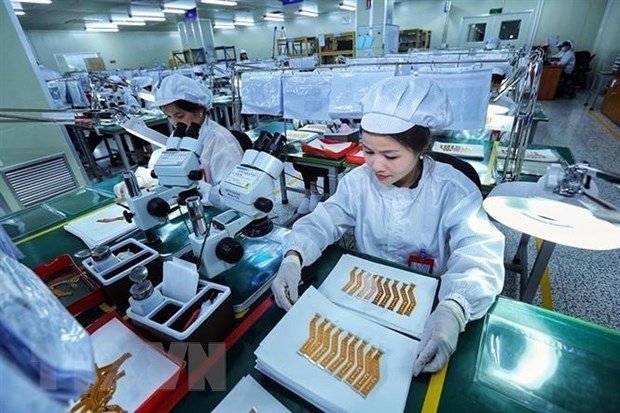 Economy
Economy

The Sa Giang Import and Export Joint Stock Company has reported a net profit of VNĐ30.5 billion ($1.34 million) on a turnover of VNĐ290.7 billion (US$12.8 million) last year.
 |
The Sài Gòn Food Joint Stock Company (Sài Gòn Food) also achieved positive business results with domestic sales soaring by 30 per cent.— Photo SaigonFood |
The Sa Giang Import and Export Joint Stock Company has reported a net profit of VNĐ30.5 billion ($1.34 million) on a turnover of VNĐ290.7 billion (US$12.8 million) last year.
They were almost 4 per cent and 11 per cent up respectively.
For Sagrimexco, as the company is known, the biggest earner was bánh phồng tôm (shrimp crackers).
The Sài Gòn Food Joint Stock Company (Sài Gòn Food) also achieved positive business results with domestic sales soaring by 30 per cent.
Hotpot was its main product.
Sagrimexco and Sài Gòn Food are among many domestic companies that are leading the Vietnamese fast moving consumer goods (FMCG) market.
Reports released recently by market analysis firms also show that in the FMCG sector, Vietnamese brands hold the upper hand over their rivals from multinational corporations in both rural and urban markets.
Kantar Worldpanel’s Asia Brand Power report released on January 15 said in rural areas, Vietnamese brands hold a 78 per cent market share. In large cities, the figure is 71 per cent.
Kantar Worldpanel’s David Anjoubault said the strengths of Vietnamese brands lie in good understanding of local markets and distribution networks.
The success is also attributed to their close co-operation with retailers.
After analysing the four largest market segments -- food, beverages, home care and personal care products -- Nielsen came to the conclusion that Vietnamese manufacturers earned 42 per cent of the FMCG sector’s total revenues.
In the food and beverage segments, Vietnamese enterprises have a market share of 69 per cent and 45 per cent respectively. In the home care and personal care segments, multinational brands have advantages, but their growth rates are lower than those of domestic ones.
Analysts said Vietnamese brands’ domination is easy to understand since they possess many advantages.
Their quality has improved recently and their prices have become more competitive while they have always had large distribution networks that take them to consumers in the remotest areas.
More and more modern retail chains are also becoming distributors for local FCMG manufacturers, thus actively helping them expand their market share.
Besides a good understanding of consumers’ customs and tastes, the local players also understand the importance of investing in technology and being flexible, all of which have helped them quickly capture the imagination of the fickle modern consumer.
With the current low consumption level in the Vietnamese market, the FCMG sector still offers huge prospects to investors.
Many analysts fear however that their impressive achievements have put many local FMCG enterprises on the radar of foreign investors, who could easily buy them lock, stock and barrel.
For instance, in just the last seven months South Korean conglomerate CJ Corp acquired over 70 per cent shares of food processor Cầu Tre Foods and 100 per cent of kimchi distributor Ong Kim.
In March last year it had shelled out $13.44 million to acquire a controlling interest in Minh Đạt Food.
CJ also bought a 4 per cent stake in Việt Nam’s leading meat processor, Vissan, when the State giant held an IPO in March 2016.
To help ward off predatory foreign investors while not violating the country’s World Trade Organsiation commitments, the analysts said the Government should have practical support policies.
They also stressed the need to simplify administrative procedures to create a fair and healthy competitive environment and help enterprises cut down unnecessary costs.
In the meantime, the Government should create conditions that enable local FMCG businesses to access loans with preferential interest rates.
Bank loans remain out of agricultural businesses’ reach
According to the State Bank of Việt Nam (SBV)’s credit department, as of June 2016 bank loans outstanding to the agricultural sector had been worth over VNĐ1.1 quadrillion (US$48.5 billion), accounting for nearly 20 per cent of the total loans outstanding.
Loans from Agribank alone made up almost 50 per cent of the total, with the remaining banks accounting for only VNĐ500 trillion ($22.03 billion).
But a study by the Ministry of Agriculture and Rural Development (MARD) found that 70.1 per cent of enterprises involved in agriculture have faced difficulties in getting bank loans, with 49.4 per cent unable to borrow at all.
Why do companies in the farm sector find it difficult to get bank loans?
According to some businesses, the process of borrowing capital from banks remains very complicated with many stringent requirements, one of which is that borrowers have to put up assets for collateral.
An SBV official said many agricultural enterprises are unable to borrow because of this requirement since they do not have assets.
Though the central bank has instructed banks to offer unsecured loans to agricultural businesses, they still make up of only 20 per cent of the outstanding loans to this sector, he said.
Analysts said banks remain apprehensive about lending without collateral despite the Government’s many support policies.
For instance, it issued Decision No.68/2013/QĐ-TTg on fully subsidising interest on loans for buying machinery and equipment to reduce agricultural losses.
But a banker revealed that the central bank is tardy in paying the interest subsidies.
Agricultural companies said the biggest problem for them in getting bank loans are the interest rates.
Though the rates for loans to agricultural projects with high feasibility are only 6-6.5 per cent, even these are too high for them because the profitability of these projects is very modest, they said.
Concurring with this, analysts suggested the Government should continue to slash interest rates and bring them down to 3.5-4 per cent.
MARD has proposed some measures in a draft decree to be submitted to the Government for approval to resolve collateral-related problems for agricultural enterprises and improve their access to bank loans.
The decree also includes interest rate support policies for them, one of which is that the rates should be 1.5-2.5 per cent lower than for other sectors.
The Government would bridge the difference in interest rates.
Analysts said it is imperative to lower interest rates for enterprises involved in agriculture and industry, thus attracting more investors to these sectors. — VNS









